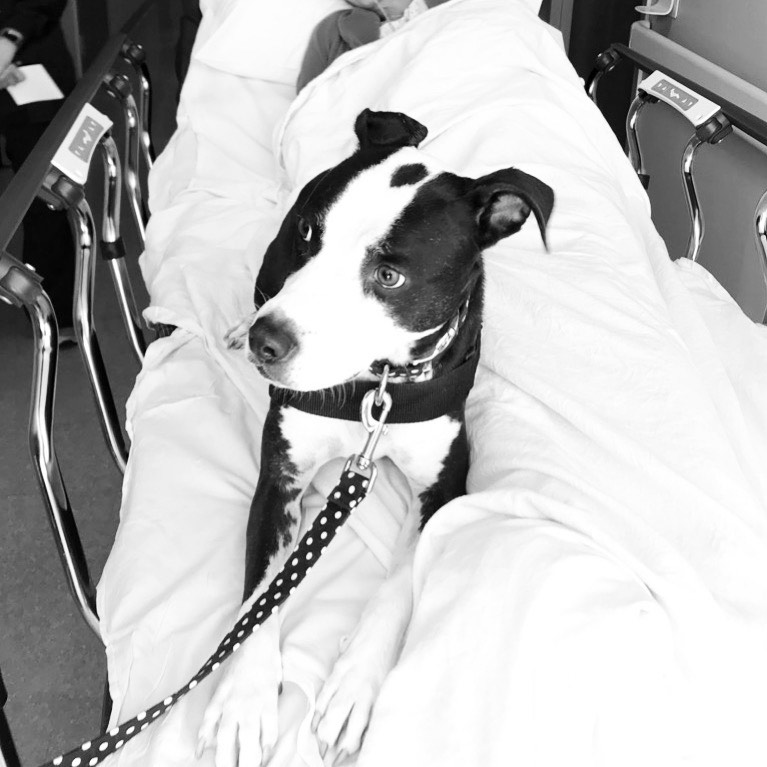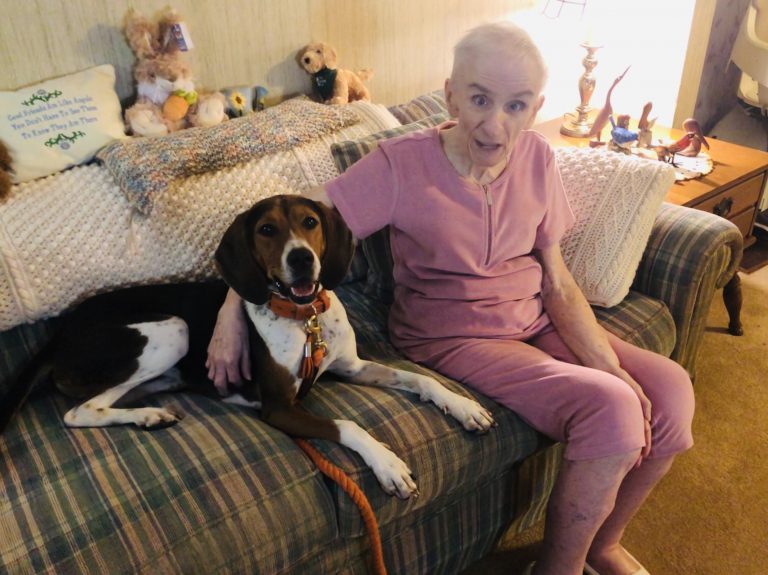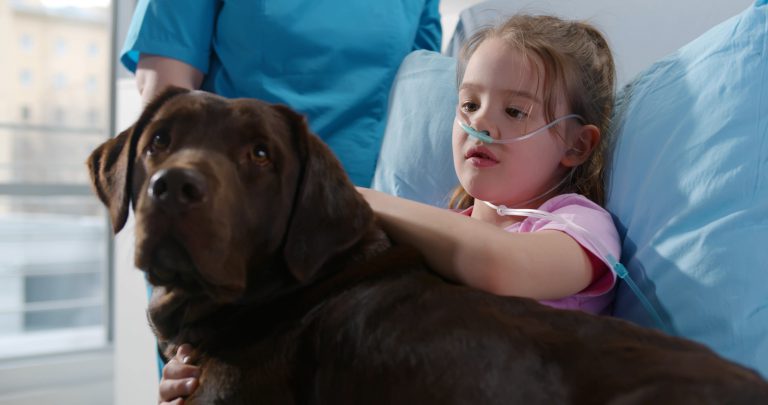Dogs offer people proven, irreplaceable comfort during trying times. Research has shown that dogs can help lower stress levels, alleviate loneliness and anxiety, and even help people cope with grief and crises.
Some dogs seem to be especially suited to comforting people, whether friend or stranger. With the right disposition and training, they can become certified therapy dogs and start visiting communities such as hospitals, libraries, assisted living facilities, and even emergency disaster areas to help people in need.
Alicia Harantschuk, president of Comfort Caring Canines Therapy Dogs, a Philadelphia-based therapy dog organization, and a trainer at Philly Unleashed, a dog training company, says that the process to train and certify a therapy dog is rigorous but simple, straightforward, and “absolutely worth it.”
If you think your dog would be suited to this work, here’s everything you need to know about training them to be a therapy dog.
What’s the difference between a therapy dog and a service dog?
Therapy dogs undoubtedly have important jobs that require advanced skills and certification, but they’re not the same as service dogs. While both receive training to conduct their jobs, there are several important differences between the two designations.
Service dogs are “individually trained to do work or perform tasks for the benefit of an individual with a disability, including a physical, sensory, psychiatric, intellectual, or other mental disability” and are legally defined (and protected) by the Americans with Disabilities Act (ADA). Each service dog you meet is trained to meet the needs of their handler, and their tasks can include pressing buttons, retrieving dropped items, alerting to a health crisis, reminding their handler to take medication, and any other job that will help the handler. Service dogs are also granted special permissions under the ADA, which allows them to accompany their handlers on airplanes, in restaurants, and in locations that don’t allow pets.
Therapy dogs do not have the same protections and privileges service dogs have. Therapy dogs are trained to comfort and improve the lives of people they meet in various settings. Though they do largely require certification, therapy dogs receive generalized training and go with their owners to designated volunteer settings such as hospitals, schools, libraries, and assisted living facilities, among other locations. Therapy dogs are working dogs, but they work in a volunteer capacity, and they spend most of their lives as pets.
There are, additionally, emotional support animals, which do not require training or certification and are also pets rather than working dogs. This is not to discount the importance of emotional support animals, which are prescribed by mental health professionals to provide companionship and help ease discomfort, depression, and anxiety.
How do you know if your dog is right for therapy dog work?
We all love our dogs and likely gain comfort from them, but not all of them are right for therapy work, which requires dogs to operate in unpredictable environments surrounded by strangers of all ages and dispositions, unfamiliar sights and sounds, and even medical equipment. So how do you know that your four-legged friend is the right fit to visit people in need of canine reassurance?
First, one thing that doesn’t matter: breed.

Photo courtesy of Alicia Harantschuk
“Like many people, I came into this assuming that therapy dogs had to be labs and goldens,” Harantschuk says. That, however, is not the case. In fact, Harantschuk’s two dogs, a dachshund and a pit bull, are both certified therapy dogs.
What matters is temperament. The most important characteristic for a therapy dog is not trainable but inherent: your dog should be friendly, patient, and gentle at all times. The advanced obedience skills required for a therapy dog in a working environment are trainable, but the disposition is not.
If your dog shows signs of discomfort or even aggression when stressed (ears pinned back, growling, or snapping), they are probably not suitable for therapy dog work.
The therapy dog certification process
To be successfully certified, dogs must go through a test that assesses both temperament and obedience skills, the twin pillars of successful canine therapy. Each organization’s certification process is different.
Some organizations will do an obedience and temperament test, then shadow you on multiple visits. Some tests are done individually; other organizations, including Comfort Caring Canines, test in groups. CCC’s test lasts anywhere from 90 minutes to two hours, though Harantschuk says, “We are not asking them to work that entire time. We keep them around us for an extended period of time to get to know them.”
Which certifying organization you choose largely depends on your needs and interests, so Harantschuk recommends that you research as much as you can before picking an organization.
For example, Katie Whiteley, the Operations Lead at the Alliance of Therapy Dogs, says that national organization requires a background check before the certification test. Certified volunteers are then required to make therapy visits at least once every three months. (This rule is temporarily suspended due to Covid-19.)
The benefits of therapy dog certification
If you believe your dog has the right temperament to be a therapy dog, the next step is to get certified.
While some organizations might allow you to bring your dog without certification, Harantschuk strongly advises against it, for the safety of you, your dog, and the people interacting with your dog. Even if you want to visit a family member at an assisted living facility, experts strongly discourage doing so outside of the therapy dog certification process.
The three most important benefits of therapy dog certification are volunteer opportunities, insurance coverage, and proof of the skills required to successfully complete the job.
Insurance coverage is particularly important: mistakes and accidents happen, and liability insurance is a must when entering the facilities where therapy dogs work.
Further, while some handlers already know where they want to volunteer—the library down the street, the elder care facility where a family member is staying—the same cannot be said of all therapy dog handlers. Most certifying organizations will help pair handlers with organizations that suit their needs and interests.
How to train your dog to be a therapy dog
There is no legally required training for a therapy dog, Whiteley says, so when looking for a training program, it’s important to beware of hefty price tags attached to anything labeled “therapy dog training” that promises official training or anything of that nature.
But Harantschuk strongly recommends taking at least a few classes. To be certified, dogs need to not only have the right temperament, but they need to be able to handle being around medical equipment, loud noises, unpredictable individuals, food, and a number of other situations that require preparation for even the most relaxed dogs.
“Even if a dog loves to be petted, they may never have been exposed to someone wielding a cane, or wrapped in a scarf,” Harantschuk says. “That situation might be slightly stressful for them, so we expose them in a controlled environment” and build their tolerance until they’re ready for a working environment.

Courtesy of Alicia Harantschuk
Start with the basics
Whiteley says that handlers working toward certification would do well to start with a good basic obedience class. “Start with puppy kindergarten and go through advanced [training],” she says. “Teach good manners: no jumping, pawing, licking, or dog aggression.”
One good barometer for a therapy dog’s obedience requirements: the AKC’s Canine Good Citizen training program (which some organizations in fact require for certification). The CGC covers 10 essential skills, including sitting politely for petting, sitting, lying down, staying in place, coming when called, and more.
If you do choose to bring your dog to a therapy dog-specific training class, it’ll be a little bit like advanced obedience class on overdrive, according to Harantschuk. Therapy dogs should have a strong auto-sit (sitting whenever they’re not moving), a strong recall (“come”), and should not jump up to greet people.
The importance of “leave it”
The “leave it” command is an advanced technique that all dogs should know, but it’s especially important for therapy dogs.
Harantschuk explains: “It is a lifesaver in a therapy dog situation: for medicine carts, people who are afraid of dogs and don’t want to be approached, open-lid trash cans, and even food patients try to offer the dogs.”
If you attend a therapy dog training course, they’ll review “leave it” every week, but you should practice it at home and on walks as often as possible.
The triple Ds
Once you have the basics down, Harantschuk says you’re going to “continually elevate duration, distance, and distraction.”
Even the most biddable dogs can’t just go from the basics of sit and stay to being surrounded by strangers and wheelchairs, so over the course of a few weeks, Harantschuk builds their tolerance, recall, auto-sit, and other essential commands, starting with quick bursts while the handler is right next to their dog and eventually escalating until the dogs are able to listen to their handlers in even the most chaotic of situations. (After all, when a dog is surrounded by 10 children all clamoring to pet them, it’s crucial for them to remain calm.)
Of course, Harantschuk also helps her canine students “get comfortable around walkers, canes, crutches, wheelchairs, IV towers, medicine carts, rolling trash cans” and more specialty equipment. This slow process of desensitization will help ease the transition into a real working environment.
Respect your dog’s boundaries
At the end of the day, your dog has their own needs and boundaries that need to be respected in order for them to thrive as therapy dogs.
People typically want their dogs to be therapy dogs so they can do some good for people, and that’s a noble thing. But some people miss that they should always be an advocate for the dog, too, to ensure they have good experiences as they are exposed to new things. “Encourage the dog to do things that might be out of their comfort zone but never force them and always respect their reactions to things,” Whiteley says. For example, she says, if a child is being too pushy with the dog, “I want my dog to know I am right there and will remove them from that bad situation because being a good advocate for your dog goes a really long way. The dog learns to lean on the handler to take over rather than feeling they need to react themselves. Having a dog that knows it has an option to leave a situation making it uncomfortable is a dog that is less likely to nip or bite at someone.”










